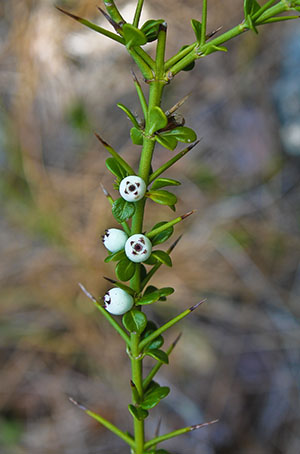Plants of South Florida · Plants by Conservation Area · Plants by County · Plants by Habitat Quick Search · Advanced Search |
||
|
|
||
 |
Catesbaea parviflora Sw. Smallflower%20lilythorn |
|
|
South Florida Status: Critically imperiled. Two occurrences in two conservation areas (Bahia Honda State Park; National Key Deer Refuge) Taxonomy: Dicotyledon; Rubiaceae. Habit: Shrub. Distribution: Native to South Florida and the West Indies. South Florida Distribution: Monroe County Keys. South Florida Habitats: Coastal berms and pine rocklands. Protection Status: Listed as endangered by FDACS and as critically imperiled by FNAI. Aids to Identification: Scurlock (1987) has color photos; Nelson (1996) has a color photo; Chafin (2000) has illustrations and a color photo. References: Chapman, 1883; Small, 1933a; Long & Lakela, 1976; Ward, 1978; Correll & Correll, 1982; Scurlock, 1987; Nelson, 1996; Wunderlin, 1998; Chafin, 2000; Coile, 2000; Liogier & Martorell, 2000. Synonyms: C. parviflora var. septentrionalis Krug & Urban. Historical Context: John Loomis Blodgett first collected smallflower lilythorn between 1838 and 1853 on Big Pine Key (s.n., NY). Many other collections have been made from Big Pine Key, where it is still present (e.g. Brumbach 9544, FSU, FTG, NY, USF). Gann observed plants in 2000 in the vicinity of the Blue Hole, within the National Key Deer Refuge. Allan H. Curtiss first collected it on Bahia Honda Key in the 1880s (1130, NY), and it has been collected there a number of times (e.g. Long et al. 2613, FSU). It is extant on Bahia Honda in Bahia Honda State Park, where it is frequent on coastal berms. Gann, Bradley and Florida Park Service biologist Janice A. Duquesnel have observed these plants as recently as 2001. Major Threats: Exotic pest plant invasions; sea-level rise. Recommendations: • Survey appropriate habitats within historical range, including private sites on Big Pine Key. • Map and monitor known stations on a regular basis. Update: Recent population estimates by Keith A. Bradley indicate that there are more than 3,000 individuals in the Florida Keys, thus changing its status to rare in South Florida. Citation: Gann, G.D. 2006-2012. Species Account Update, Floristic Inventory of South Florida Database Online. The Institute for Regional Conservation. Delray Beach, Florida. |
||



